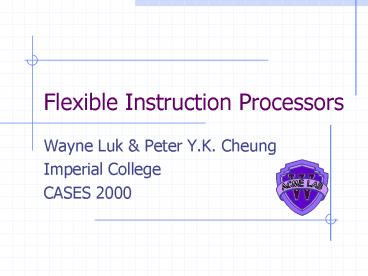Flexible Instruction Processors - PowerPoint PPT Presentation
1 / 15
Title:
Flexible Instruction Processors
Description:
GPPs lose performance when dealing with non-standard ... Implemented in Handel-C. send instruction. receive done. receive. instruction. decode() switch ... – PowerPoint PPT presentation
Number of Views:21
Avg rating:3.0/5.0
Title: Flexible Instruction Processors
1
Flexible Instruction Processors
- Wayne Luk Peter Y.K. Cheung
- Imperial College
- CASES 2000
2
Not So General Purpose Processors
- GPPs lose performance when dealing with
non-standard operations and data - Particularly apparent in embedded systems
- Cell phones
- Medical appliances
- Digital cameras
- PDAs
3
Two roads to customization
- Augment GPPs with programmable logic
- Couple standard processor (ARM, MIPS) with an
FPGA fabric - Fixed processor instruction set
- FPGA implements custom instructions
- Implement them in FPGAs
- Customize instructions at compile time or at run
time
4
Flexible Instruction Processors
- FIPs are assembled by parameterized processor
templates - Allows customized hardware to be exposed as new
instructions - Critical resources can be adjusted according to
domain requirements - Can implement same instruction set with different
design tradeoffs
5
FIPs Template
- Templates are modules connected together by
communicating channels - Can instantiate different styles of processors
- Stack, register, etc.
- Customizations
- Removal of resources
- Changing data widths
- Vary degree of pipelining
- Implemented in Handel-C
6
Enhancing Processor Templates
- Can group modules differently to achieve
different processor styles - Superscalar
- More than one execution module
- Hybrid
- Different execution modules (stack/register)
Fetch
I1
Execute
Execute
I2
7
Compilation Strategy
Source Code
- Optimizes known target code to known target FIP
- Reorganizes code to take advantage of ILP
- Similar to Javas Just-In-Time compilation
Annotate with possible optimizations
Compile with standard compiler
Compiled Code
AnnotatedSource Code
Optimize compiled code for target FIP
Compile with generated compiler
Hardware Description
8
Compilation Strategy
Source Code
- Annotate source code with profile information
- Frequency of instruction use
- Common instruction groups
- Shared resources
- Use annotations to drive optimization of code and
FIP - Compile with a FIP-specific compiler
Annotate with possible optimizations
Compile with standard compiler
Compiled Code
AnnotatedSource Code
Optimize compiled code for target FIP
Compile with generated compiler
Hardware Description
9
FIP Optimizations
- Custom instructions
- Direct hardware implementations can be exposed by
custom instructions - Reduces number of fetch-decode instructions
- Increases area
- Processor-specific
- Can replicate much-used resources
- JVM allow concurrent reads of top of stack
- JVM allow reads of top n elements
10
Implementation JVM
- Implemented FIP-based Java Virtual Machine
- 1 segregated resources that are shared
- Good area utilization and the expense of routing
congestion - 2 two-stage pipeline only shares stack and
main memory - 3 deeper pipelines for certain instructions and
register style improvements - Top-of-stack registers are replicated writes
are done back to stack directly, replicated
registers updated during the fetch cycle - Most instructions have 4 stages, some 5-6 stages
- Routing is pipelined
11
Results
12
Results
Devices CaffineMark Speedup Software
JVM 502 1 FIP JVM 1019 2x Pipelined FIP
JVM 3665 7x GMJ30501SB 13332 27x
FIP implemented in Xilinx Virtex
_at_33MHz GMJ30501SB 200MHz ASIC
13
Impact of custom instructions
- Link list insertion (100 links)
- Direct hardware 2.3ms
- FIP-JVM 6.4ms, 22 instructions
- ASIC 1ms
- Adding insert link instruction
- 12 cycles to complete
- Saves 10 cycles and 10 fetch/decodes
14
Implementation AES
Device Cycles/Block Slices/BRAM Mbps/MHz Softwar
e 340 N/A 0.4 FIP (I) 99 1770/2 1.3 FIP
(II) 32 1393/10 4 Hardware I 11 460/10 11.5 Hard
ware II 1 2679/82 129.6
FIP (I) direct implementation of transforms FIP
(II) table-lookups for transforms Hardware I
Spartan II 100-6 Hardware II Virtex-E 812-8
15
Optimizations
- Opcode chaining
- Store intermediate results in temporary registers
- Removes push/pop and alleviates sequential nature
of stack-based machines - Galois Multiplication is single instruction
- No procedure call overhead
- 8.5 cycles instead of 30
- Introduce predicate registers to allow
instructions to execute in parallel - 6 cycles instead of 30































